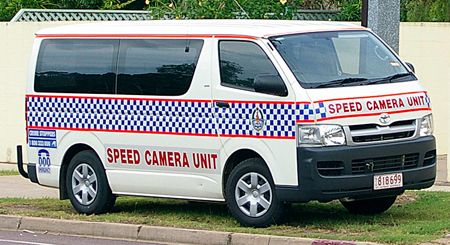Cop cars go under cover
11 November 2015
 As of today, spotting a speed camera van in the Territory is about to become very difficult: All NT police mobile speed camera vehicles will have police markings removed and all speed camera activity will now be undertaken covertly, says Acting Commander Bob Rennie.
As of today, spotting a speed camera van in the Territory is about to become very difficult: All NT police mobile speed camera vehicles will have police markings removed and all speed camera activity will now be undertaken covertly, says Acting Commander Bob Rennie.
“This strategy brings the Northern Territory in line with other jurisdictions around Australia,” he says, and during the trial, speed camera locations will not be publicly released.
“The ultimate aim is to reduce the incidence of speeding and road trauma in the Northern Territory.” The current road toll stands at 41, compared to 36 at the same time last year.



I’m wondering who’ll pick up the tab for the police vehicles being illegally parked on the footpath – or is it “do as I say, not as I do”?
This strategy will increase $$$ revenue equal to other jurisdictions. Fixed location speed cameras do the same thing without police officers playing hide and seek.
The best thing for you guys is stop whining and don’t speed. What pathetic comments.
Don’t speed and you won’t have a problem. Only the guilty will be affected.
Mark if you read the traffic act you will realise they are not illegally parked.
The driver of an emergency service vehicle is exempt from the provisions of the Act. So no regulation breached, no fine, no tab.
This rule is so police and other emergency services can do their job.
Would be hard for them to race to your house in an emergency if they weren’t allowed to break the speed limit, or go through red lights etc.
I understand fully that there are situations in which all emergency services personnel do have to take specific actions that may be seen as breaking the law in some eyes – but I fail to see how a vehicle with the sole purpose of speed detection can ever be classified as an emergency vehicle.
Whilst there is no condoning dangerous speeding, it is important that the bigger picture is considered.
Cars are by far safer than ever, yet jurisdictions through out Australia continue to install more speed devices and overwhelmingly trend posted speed limits downwards (well done NT on using some common sense on parts of the Stuart Highway).
Revenues from these devices continues to be a major cash flow for Governments (about two billion a year) and despite rhetoric of their effectiveness, the greatest improvements to road tolls has come through the introduction of active safety devices in side the car, such as anti lock braking, stability control and airbags.
Driver behavior has not seemed to have greatly improved.
How will the ever greater push to reduce speed work in with a future of autonomous vehicles that remove human error and open up the possibility of almost zero road toll?
When will improvements to infrastructure be given the same importance as speed reduction?
How many people die when they hit an overhead power line that could instead be buried under the ground?
Posters below should consider these questions before simply saying “nothing to hide, nothing to fear”.
The same arguments can be made of our ever decreasing rights to privacy in this Government surveilled world.
Visibility is a deterrent. Invisibility is not, and instead dishes out a fine seven days later but does not immediately reduce the speed.
New York City, the safest city in the US, understands the value of visibility and lines the streets with marked police cars. An unmarked car is not a deterrent.
Temporary Beat Locations (a successful policy) are manned by police in high visibility as a deterrent, not by plain clothes police.
Highways England has recently announced they will be repainting all their stationary radar devices to bright yellow as they believe this will lead to improved safety and reduce widespread discontent with the current system.
Transparency and visibility is a cornerstone of civil liberties and no action which moves Government activity from observation should be taken lightly or considered in isolation.
I remember back in the early eighties driving the dual lane highway from Nambour to Brisbane (OK im not that old, mum and dad were driving).
Under most overpasses there were motorbike police, highway patrol and radar operators under the shade of these overpasses.
Problem was you never knew which one. So the entire length of the trip was done right on the speed limit, usually backing off a couple of k’s when you saw them.
Occasionally they had another group at the next overpass for those that sped up once they were past the first one. Got caught? Usually a fine as well as a stern talking to.
Sometimes the unmanned cameras are set with no tolerance. I believe motorists had a lot more respect for a copper who gave a common sense warning, and good PR too.
Visual deterrents do work, but don’t raise as much cash as the covert ones. If we all drove like there was a camera up the road, speeding would reduce.